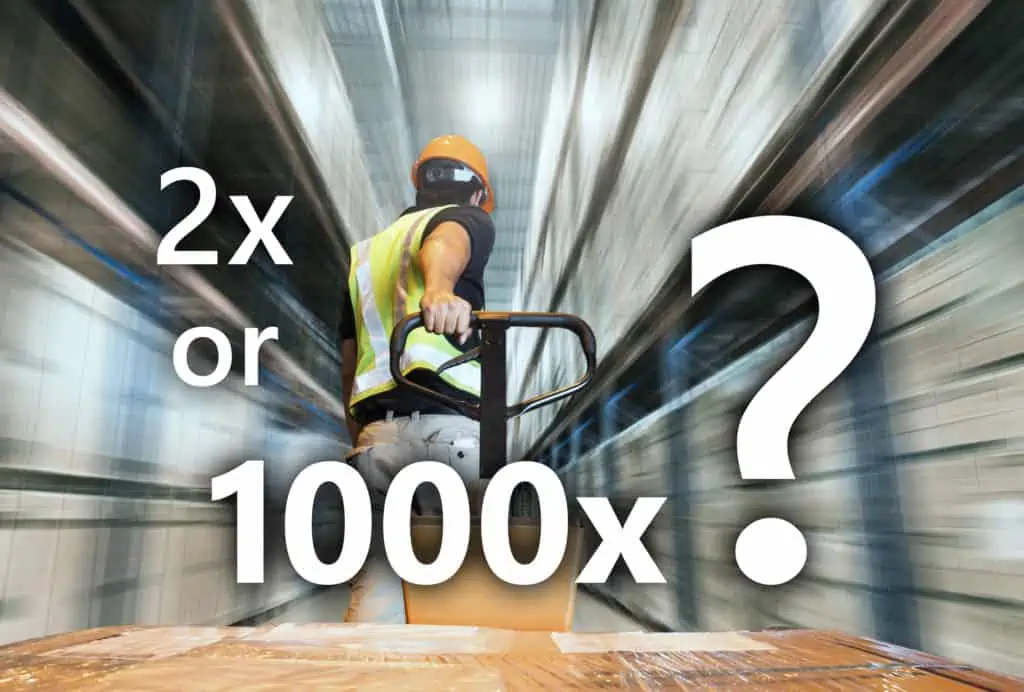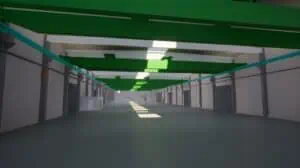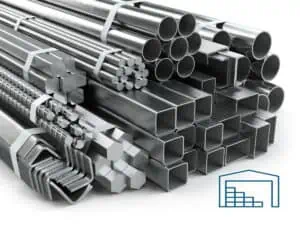AGVs (automated guided vehicles) are also on everyone’s lips when it comes to forward-looking logistics concepts. Driverless is often seen as the next, higher goal after forkliftless. In lean management, however, tugger trains are the means of choice. Are AGVs now making tugger trains obsolete?
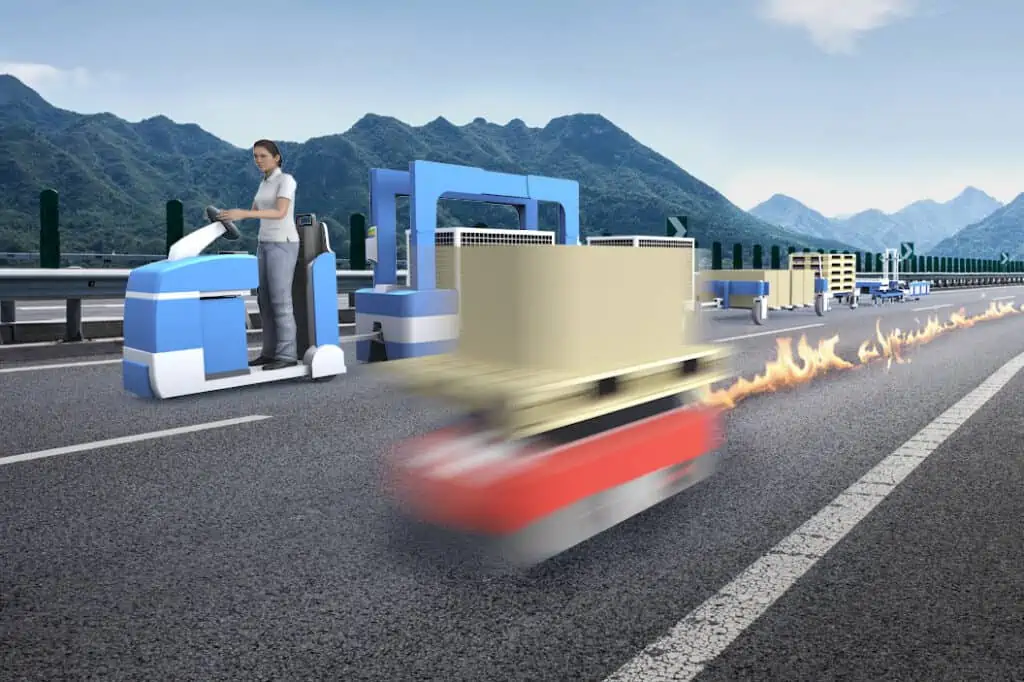
In terms of transport history, the development in the 20th century from the railroad to the individual means of transport, the automobile, is an obvious comparison. Can parallels be drawn? And what does it mean for factory and logistics planning?
The physics of intralogistics
Let’s start with the second question: Transports and in particular their intensities are a central expense parameter in factory operation. When planning layouts, one therefore always tries to keep sources and sinks with high transport intensities as close together as possible. This is based on the assumption that transport volumes lead to transport costs in proportion to the length of the path. From an energetic point of view, this is also essentially true. If, for example, 2 tons of material are to be transported, it will probably cost more energy to convey them over 500 m instead of over 20 m, at least if the same vehicle is assumed.
What is the meaning of transport intensity?
Read more here:
Material flow analyses in two dimensions
At this point, the analysis becomes more complex. This is because physical and economic costs are by no means equivalent. Evaluating transport with costs, further resource costs get in focus adding to the energy requirement. In addition, there are coordination costs for controlling the transport system. The tendency is for greater distances to be covered in larger batches. This reduces the number of transports required, while the capacity and performance of the vehicles used must increase in equal measure. Taking our example of the 2-ton transport, it may be economically justifiable to transport this mass over 500 meters with a forklift or tugger train, while it must be considered uneconomical to carry 2 tons of material by hand over 20 meters.
This brings us to the next level of complexity, time. How often what quantity is needed at the sink? Does it make sense to distribute 2 tons of material in one go or can this quantity not be processed at the sinks at all at the time of delivery? Does this mean that additional space is required for buffer areas, space that would not be necessary if the material were supplied more frequently in smaller batches?
AGVs & Co. – spoilt for choice
The choice of different logistical systems creates amplification and cancellation effects that are difficult to consider comprehensively from the outset. Thus, each solution will reveal advantages and disadvantages. In any case, the necessary quantities per unit of time determine the logistical necessities. With a tendency towards more individual products, smaller batch sizes seem to be the consequence. The development of modular products, on the other hand, counteracts this. This is because such products contain many identical preliminary and intermediate products. These are required in larger batches and are produced continuously. This creates rhythm in production. High-capacity, synchronized logistics trains are then an advantage. Tugger train systems with variable trailers for different types of load carriers increase the flexibility of such solutions. If, on the other hand, the requirements are smaller and not cyclical, smaller vehicles with individual routes are attractive. The use of automated guided vehicles (AGVs) is an option in this case.
Does the future belong to automated guided vehicles?
Since AGV solutions have not yet been in relevant use for very long, we would like to take a look at possible long-term effects. Passenger and freight transport outside factories will serve as a parallel. As a mental experiment, we may equate the automobile in public transport with an autonomous driverless vehicle in production.
A look back
If we look at the public transport network at the beginning of the last century, it was dominated by the long-distance railroad, the equivalent of the tugger train system in the factory. Railroad stations were the logistical nodes. From there, goods and people were distributed by smaller vehicles. As a result, manufacturing companies tended to develop close to railroad stations. Industrial sites depended on a railroad connection.
The resulting urban structures formed comparatively densely since there was a lot of transport to be done on foot or with handcarts. An economically viable rail connection had to be provided on the shortest possible route to the nearest logistics node. The manufacturing structures practically followed the energetic optimum for the flow of materials described at the beginning.
A long-distance road network practically did not exist at that time. This also eliminated the option of transporting goods directly between source and sink without using rail logistics. Today, things look different. Millions of small and large vehicles move along sometimes overloaded main traffic arteries, and traffic jams are not uncommon. For this reason, trunk roads have been continuously expanded in recent decades, while German rail networks, for example, have seen virtually no expansion, especially in freight traffic.
The truck – the AGV equivalent of global logistics
The possibility offered by trucks to load large load carriers from almost any location and to receive them directly has been used more and more intensively. Due to advantages in flexibility and throughput time, manufacturing companies were able to economically compensate for energetic disadvantages compared to a rail logistics train. As a result, compact industrial complexes were replaced by production sites spread further out in the regions. Hardly a rural community was still without its own industrial park. Efficient feeder roads were usually part of the equation because large trucks with trailers had to be handled.
The individualization of traffic also led to more vehicles in the cities. Even subordinate roads had to be made wider and more efficient. In addition, not all vehicles were always in use, parking and buffer areas became increasingly scarce; the maintenance and spare parts market gained in importance. So today, the demands of massively individual means of transport not only tie up a lot of land directly but also indirectly.
Conclusion
In industrial production, the material movement has been considered wasteful at least since Womack´s, Jones’s, and Roos´s “The Machine That Changed the World: The Story of Lean Production.” In terms of energy, this is self-evidently true. Lean production is characterized by spatial compactness and short distances. They thus tend to follow the pattern of the centers of the early industrial era, which were supplied by rail. Transferred to the factory, the railroad can certainly be seen as the equivalent of a tugger train system.
Today’s tugger train solutions face the utilization and flexibility problems of the railroad with sophisticated systems for tugs and tugger train trailers. Optimal curve behavior limits the space required. One disadvantage of the tugger train can certainly be seen in the complex planning of the intralogistics. After all, the tugger train system has to supply all points of consumption just-in-time – professional material flow planning is indispensable for this.
Getting a factory layout without logistical waste
Please see the blog:
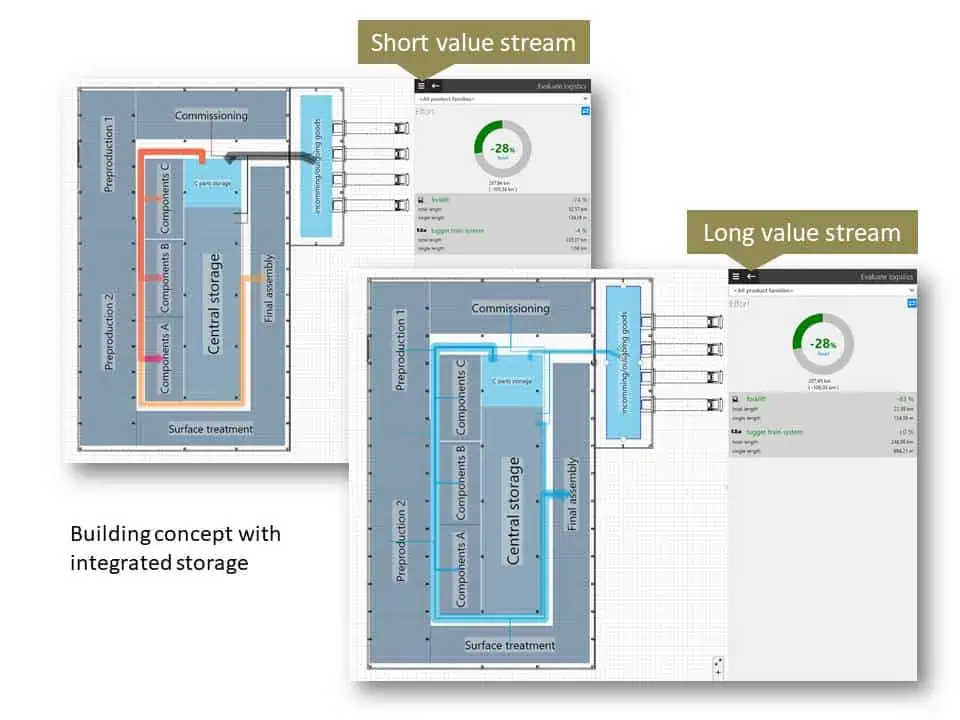
Driverless transport systems, on the other hand, stand for enormous flexibility, similar to the automobile. A few examples initially generated enthusiasm, but there is a complexity risk in the mass of autonomous vehicles, combined with a tendency toward increasing space requirements for transport routes. So at least if the development of passenger and freight transport in industrialized nations is taken as a comparison, the AGV does not appear to be suitable as a means of transport to replace tugger train systems, despite simple integration in the Industrie 4.0 environment. Rather, AGVs will supplement where supply requirements arise rather spontaneously.
Related topics:
- Material flow analysis in two dimensions
- What you should definitely know about Material Flow
- Material flow planning software
No problem, simply subscribe to our Blog-News!
